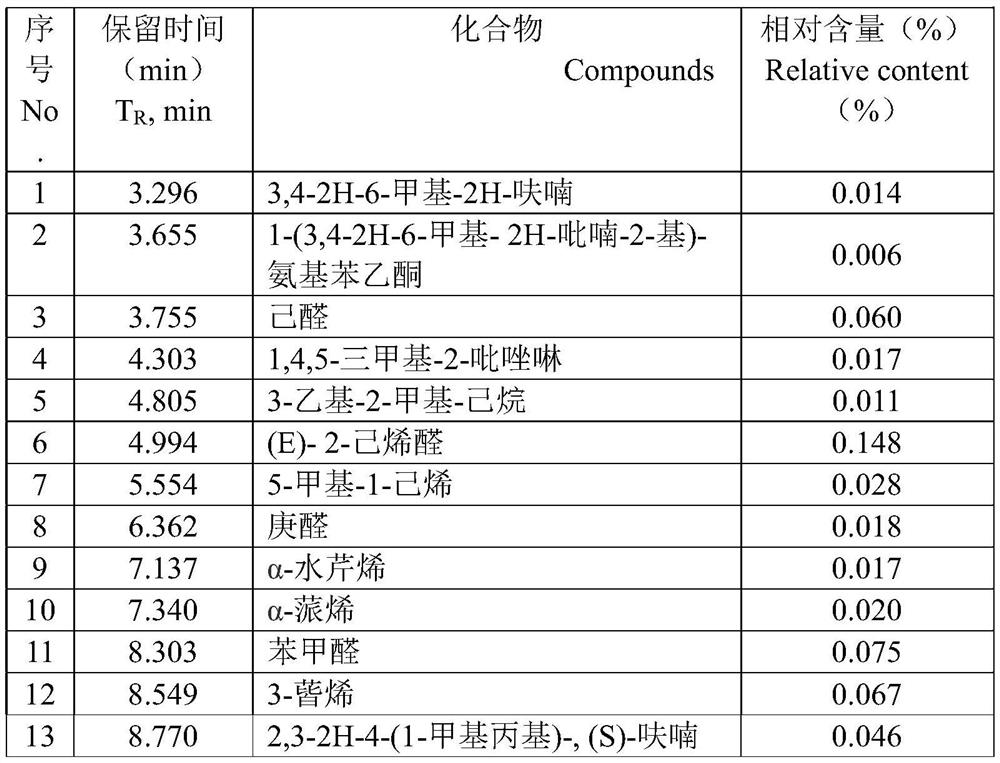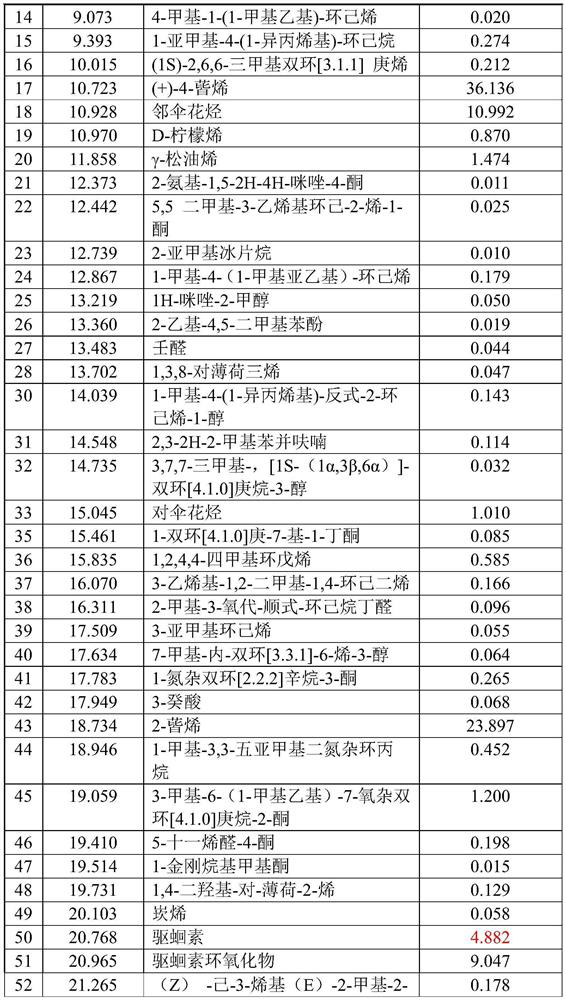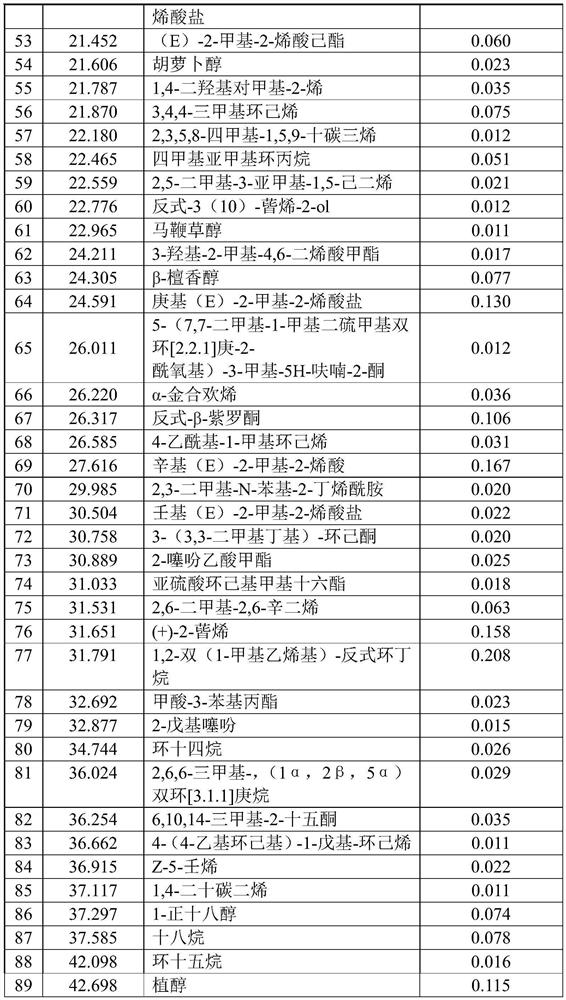Chenopodium ambrosioides volatile oil and application thereof in prevention and treatment of corn weevil and pholiota adiposa
A technology of Nepeta nepeta volatile oil and Tribulus chinensis, applied in application, insecticide, animal repellent, etc., can solve unsolved problems
- Summary
- Abstract
- Description
- Claims
- Application Information
AI Technical Summary
Problems solved by technology
Method used
Image
Examples
Embodiment 1
[0019] Example 1: Extraction and determination of the volatile oil of Schizonepeta yunnanensis
[0020] The above-ground part of Nepeta nepeta in this example is collected from Yiliang County, Kunming City, Yunnan Province, longitude: 103°3′43″, latitude: 24°58′27″, altitude: 1742m, through the Dendrology Teaching and Research Office of Forestry College, Southwest Forestry University Dr. Liu Weiyi identified it as Dysphania ambrosioides of Chenopodiaceae, and it was dried in the shade for later use.
[0021] The extraction process of the volatile oil of Nepeta yunnanensis is as follows: cut the fresh Nepeta yunnanensis sample into pieces, put it into a 1000mL round bottom flask, add appropriate amount of water, use a volatile oil extractor, extract by steam distillation for 5 hours, and obtain a light yellow oil The material was freeze-dried, formulated into solutions of different concentrations, and stored at -4°C for future use.
[0022] The determination procedure of Nepet...
Embodiment 2
[0031] Example 2: Application of the volatile oil of Nepeta yunnanensis in the prevention and control of corn weevil and red beetle by fumigation
[0032] (1) Experiments of corn elephant and red-spotted corn beetle
[0033] The source of corn weevils for testing is provided by the Natural Fun Insect and Plant Hall of Qushou, Xichuan County, Nanyang City, Henan Province, in a constant temperature incubator (temperature 27°C ± 2°C, relative humidity 75% ± 5%, photoperiod L: D = 16h: 8h ) were fed with wheat, placed in an insect culture room for 7 days, and then the adults were screened out; after a new generation of adults emerged in large numbers for about a week, the adults were screened out as test insects.
[0034] For the test, the source of the red pseudograss is provided by the Natural Interesting Insect Plant Hall of Xichuan County, Nanyang City, Henan Province, cultivated in an indoor artificial climate incubator (temperature 27 ° C ± 2 ° C, relative humidity 75% ± 5%,...
Embodiment 3
[0046] Example 3: Application of the volatile oil of Nepeta yunnanensis in the prevention and control of corn weevil and red beetle through contact killing
[0047] (1) Experiments of corn elephant and red-spotted corn beetle
[0048] With embodiment 2.
[0049] (2) Determination of contact activity
[0050] The contact killing activity of the volatile oil of Nepeta nepeta on the corn weevil and the red beetle was determined by the micro-drop method. Determine the test concentration range through preliminary experiments. The contact concentration of nepeta volatile oil on corn weevil is: 112.5mg / mL, 56.25mg / mL, 28.125mg / mL, 14.06mg / mL, 7.03mg / mL. The contact concentrations for Trichosmus chinensis are: 50mg / mL, 10mg / mL, 2mg / mL, 0.4mg / mL, 0.08mg / mL. Use a pipette to take 0.5 μL of solutions of different concentrations and drop them on the pronotum of the corn elephant and the red corn beetle. Each concentration treats 10 test insects, repeats 5 times, and transfers them to ...
PUM
 Login to View More
Login to View More Abstract
Description
Claims
Application Information
 Login to View More
Login to View More - R&D Engineer
- R&D Manager
- IP Professional
- Industry Leading Data Capabilities
- Powerful AI technology
- Patent DNA Extraction
Browse by: Latest US Patents, China's latest patents, Technical Efficacy Thesaurus, Application Domain, Technology Topic, Popular Technical Reports.
© 2024 PatSnap. All rights reserved.Legal|Privacy policy|Modern Slavery Act Transparency Statement|Sitemap|About US| Contact US: help@patsnap.com










